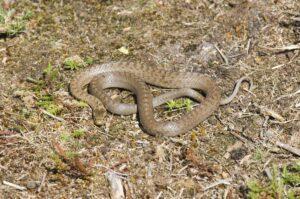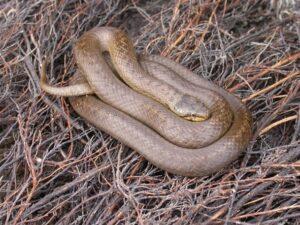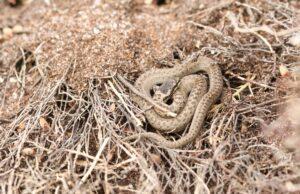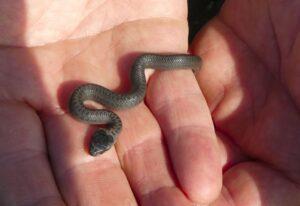The smooth snake is endemic to the UK. It is the rarest reptile in the country and is threatened by the degradation and loss of heathland habitats. Being terrestrial, it spends most of its life in the ground and can only sometimes climb up low shrubs. Its main defense against its predators is its camouflaging ability.
Scientific Classifications
- Suborder:Serpentes
- Family:Colubridae
- Genus:Coronella
- Species:C. austriaca
Conservation Status
Subspecies
This snake has two recognized subspecies.
- Coronella austriaca austriaca
- Coronella austriaca acutirostris
Description
Size
The average length of the snake is 24-30 inches (60-75 cm).
Color and Appearance
The colubrid is gray, reddish, or brown with a paler belly. Black markings are arranged in rows of dots or crossbars down its back. The scales are flat and smooth to the touch. There is a dark heart-shaped mark resembling a crown on its head, justifying its genus name, Coronella. A dark line runs along the side of its head and through the eye that has circular pupils. The tongue is dark red or reddish brown. The upper labials are grayish-white, whitish, or light brown and can have darker spots. It has a rostral scale that is as long as it is wide.
Are They Dangerous to Humans
The snake may secrete a foul-smelling substance from its anal glands when threatened. If caught, it will strike but can’t cause danger as its bite is non-venomous. So the defense mechanism only acts as a deterrent to its attacker.
Smooth Snakes at a Glance
Distribution
It is found across Europe, northern Iran, and parts of Russia.
Habitat
It lives in the heathlands and moorlands.
The solitary and secretive colubrid basks in the sun during the day avoiding open areas and prefers to hide in leaf litter, rock crevices, vegetation, underground holes, and under stones. It hibernates from October-April.
Lifespan
The smooth snake can live up to 30 years.
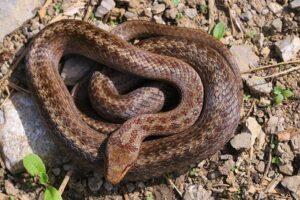
Predators
Birds such as carrion crows, pheasants, and birds of prey and mammals such as badgers, red foxes, and weasels prey on it.
Diet
The diurnal constrictor eats slow worms, sand lizards, nestlings, and insects. It coils around its prey to suppress it and often crushes it to death.
Reproduction
Ovoviviparous (gives birth to live young from eggs that hatch inside the body)
In spring, males compete to win over females for mating. They give birth to 4-15 young in September. The babies resemble the adults in their looks.
Similar Species
Adder
Though the adder, Vipera berus, looks similar, it has a thicker body, less rounded head and the dark pattern on its back is more defined. Its scales are keeled.
Source
images.immediate.co.uk, pbs.twimg.com, mediacdn.cincopa.com, balcanica.info

